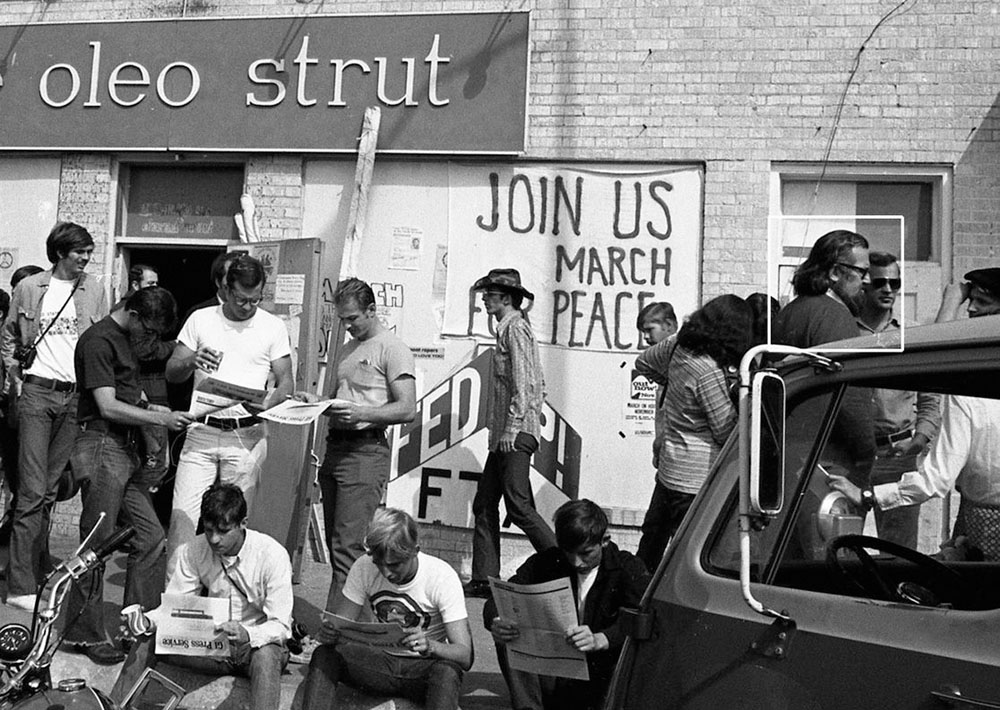 |
Oleo StrutBy Paul DonahueI was not a witness to 1968; my view of the world from Chu Lai as a guest of the US government that year was quite limited. I was not a witness to anything in this story. In fact, I had no idea it happened at all for 50 years. Tom Cleaver, aviation historian and Tonkin Gulf explainer, who was there, first brought it to my attention. Through his and others writings of it and searching the archives of places like The Rag Blog I've attempted here to tell the story of how some active duty GI's resisted a war they thought was wrong.
At the height of the Vietnam War in the late 1960's and early 1970's the mood of the country changed, and the attitude of war-weary GI's in the field changed also. There were increases in the incidences of fragging along with refusals to engage the enemy. When these exhausted soldiers rotated out and returned to "the world," some brought a new anti-war sentiment with them. If the soldiers had just a short time left to serve they were simply discharged, like me. If not, they were sent to posts around the country and given something to do to occupy their time. Thousands were sent to Fort Hood in Texas, where this story takes place. In the summer of 1968, the Army began training the returnees at crowd control. The guys didn't know or care why. They were just killing time, decompressing, it was fine with them. Off post, there was almost nothing to do. The locals in the town of Killeen, Texas didn't like or trust the GIs much. For the black guys, it was worse—the KKK was active there. One of the gathering places for these soldiers was a newly opened coffee house. There were GI coffeehouses springing up around the country at the time, and they became the center of the anti-war movement within the military. There was one called the UFO (think USO) outside of Fort Jackson in South Carolina and others outside Fort Leonard Wood (Missouri) and Fort Polk (Louisiana). The coffeehouse outside of Ft. Hood was called The Oleo Strut. The name came from a helicopter shock absorber; they thought it was appropriate. Late in the summer, somewhat before the Democratic National Convention in Chicago, word had it that they were to ship out to the Great Lakes Naval Training Center and ordered to crowd control for the thousands of anti-war protesters that everyone knew were coming. These vets were in no mood to crack the heads of "hippies and commies" who were protesting against a war that they knew was wrong. Some thought about fleeing to Mexico; they thought about desertion. And one night at the Oleo Strut they cooked up a plan. They thought about printing yellow 2 x 2 cards with a white hand showing the peace sign and backed by a black fist. They printed 1,000 of them. The plan was to put the cards on their helmets to show the protesters that as soldiers they understood and shared their struggles. The command structure caught wind of their plan because they had, you know, spies. In the Deep South, the Army sort of self-segregated; about 100 black soldiers gathered in a field on post to talk it out. They decided that they weren't going at all. By morning some still remained, waiting for answers on their demands from command. Those that chose to stay all had either a purple heart or a bronze star; they were not going to be called cowards for not deploying. Their answer came when they were ambushed by MPs, beaten, and arrested. As a result of taking a stand, 43 black GIs faced courts-martial for their actions and were all punished with dishonorable discharges, or worse. The rest of the GIs didn't know the fate of their black brothers and were sent to Chicago. The Army was afraid of the spectacle that would be caused by soldiers switching sides and joining the protesters. The thinking was that if 1,000 of them were deployed and only ten or twenty defected on live TV, it would have been disastrous for the Army. The GIs were never used for crowd control. Without military back-up the Chicago police took things into their own hands and produced their own disaster as the nation witnessed the broadcast of police riots outside the convention. Inside the convention, the audience was treated to Senator Abraham Ribicoff denouncing from the podium, "...Gestapo tactics in the streets of Chicago." Sitting in the front row, Chicago's Mayor Daley in response shouted obscenities in reference to the Senator's religion. In the years after the war's end, the GI coffeehouses began to close, one by one. The Oleo Strut closed in 1972. How much the activism born in them aided in ending the war can be debated, but the search for peace never ended for some of those who were there. Many of their brothers carry that spirit to this day. Stories like this, though sometimes, unfortunately, lost to history, still contribute to the arc of the peace movement of today, fifty years later. Paul Donahue was born and still lives in Schenectady, N.Y. He is retired from GE Global Research where he worked for 38 years.
|


